If you’re looking to understand how to identify sales opportunities, take a moment to think about your business’ approach to sales opportunity management. Do any of the following statements ring true?
- You don’t know if the opportunities in your pipeline are viable.
- You don’t know which opportunities to focus on.
- You take hours or days to follow up on opportunities.
- You don’t know your ratio of won-to-lost opportunities.
If any of the above apply to you, potential deals are likely slipping through the cracks.
Luckily, this blog will equip you with the top five best practices for opportunity management so that you never leave revenue on the table again.
Keep reading for a complete overview of what opportunity management is and how it helps you grow your business faster. Let’s dive in!
What is opportunity management?
To kick things off, let’s look at what opportunity management is. Simply put, it’s the process of managing and organizing your potential sales.
Sales opportunity management (or sales pipeline management) involves tracking potential sales as they move down the funnel. A key tactic when deciding how to identify sales opportunities is to prioritize your efforts on the highest-value deals that are most likely to go through.
Why does sales opportunity management matter for my business?
Sales opportunity management is important because it helps you be more efficient with your sales. Effective sales opportunity management lets you better understand your customers and prioritize your interactions with them based on their potential.
Now that you’re familiar with opportunity management and its importance in your business, let’s look at how to identify sales opportunities.
What are leads and opportunities?
In short, a lead is a sales prospect, while an opportunity represents a potential deal with a qualified prospect who has a high chance of converting to a customer.
A sales opportunity should have a pain point that the product or service that you are selling addresses. A lead, on the other hand, is someone with a general interest in your product or services.
Next, let’s dive into the role of leads and opportunity in sales.
Lead and opportunity management in sales
When it comes to sales, opportunity management is about converting your potential customers and leads into recurring revenue. To achieve this, simply understanding how to identify sales opportunities isn’t enough. Instead, sales managers need to have the proper system in place to keep track of their opportunities as they progress through the pipeline.
Using opportunity management for your business has several benefits. It lets you:
- Optimize your opportunity pipeline workflow: You will be able to standardize your sales process and keep your opportunities moving forward.
- Increase your win rate: By seeing what you need to do next in each step, you can apply proper sales techniques.
- Gain a better understanding of your opportunities: It will be much easier to see which opportunities matter the most.
For small businesses using an accounting software like QuickBooks, the opportunity management process may be messy or nonexistent. After all, accounting software is set up to track real sales from confirmed customers — not potential business from prospective customers.
That’s where a CRM comes in handy.
Examples of sales opportunities
There are many sales opportunities you can find as a small business, depending on the market you’re in.
If you’re in a mature market, you might find opportunities by:
- Creating targeted sales aiming at a new demographic.
- Developing new products to find another customer base.
For growth markets, you can look into:
- Expanding your distribution channels.
- Creating new business models, like building physical locations or adding an online store.
And if you’re in a frontier market, you can try:
- Overcoming competitors by coming up with new value propositions or collaborations with major players.
- Getting more market share by selling to other customers in the same niche.
Elevate your opportunity management with a CRM
For those of you asking yourself, “What does CRM stand for?” the answer is simple: customer relationship management. In this case, it refers to CRM software.
For many business owners, a CRM is a great way to keep track of leads and opportunities at every stage of the sales pipeline. Better yet, a QuickBooks CRM like Method helps you:
- Manage leads directly from your Gmail or Outlook inbox.
- Simplify your finances from end to end.
- Instantly capture sales prospects with lead gen forms.
- Eliminate double data entry.
- Gain a 360-degree view of every customer.
- Stay organized with information that’s always up to date.
Regardless of the CRM you choose, using one is definitely a best practice when it comes to managing your sales pipeline, opportunities, and operations effectively.
Now that you understand the foundation that a strong opportunity management process needs, let’s look at how to identify sales opportunities to build your sales pipeline up.
How to identify sales opportunities
Analyze your customer behavior and build a persona
Investigate your customer’s behavior, preferences, and needs to build detailed customer personas. A well-researched buyer persona helps you tailor your sales strategy to better resonate with your target audience.
Review purchase history and budget
Assess your customers’ previous purchases and their average spend to reveal buying patterns. A potential upselling and cross-selling opportunity is pinpointed by tracking buying behaviors.
Review current events
Staying informed about current events and industry trends helps you identify new sales opportunities. Also, changes in market dynamics or technology can uncover new avenues for your business.
Work with sales-qualified leads
A sales-qualified lead is differentiated from regular leads because they show a genuine interest in your product or service and are more likely to convert into sales. When your sales teams recognize qualifying leads, your time is prioritized by potential return on investment.
Use customer referrals
One of the best tips is to encourage your existing customers to refer new customers. This often results in high-quality leads, as they come in with a level of trust and credibility.
Establish third-party referrals or affiliate programs
In the same vein of customer referrals, you can collaborate with other businesses in similar industries to generate referrals. This expands your reach and brings in leads that you might not have accessed otherwise.
Use CRM software
CRM software simplifies the process of tracking and managing sales opportunities. It provides customer data analysis and sales metrics for better decision-making.
When your customer is monitored through CRM tools, he or she:
- Is assessed through sales funnel metrics.
- Is filtered from non-qualifying leads.
- Is profiled based on buyer personas.
- Is analyzed through customer interactions and feedback.
What is the difference between a lead and a sales opportunity?
The main difference between a lead and a sales opportunity is that a lead is a potential customer who has shown interest in your product or service. On the other hand, asales opportunity is a qualified lead that has a higher likelihood of converting into a sale.
The key difference is the sales opportunity is further down the sales funnel with a higher likelihood of making a purchase.
Now that you know how to identify sales opportunities, let’s take a closer look at what you do with an opportunity once you have it.
Sales opportunity management software
A sales opportunity is the stage where you introduce your product to a lead in hopes of landing a sale. This stage often involves stakeholder meetings, presentations, and demos — things that showcase your product and position it as a solution to the client’s problems.
Sales opportunity management software collects customer information in a report that, ideally, is reviewed during sales team meetings. This software helps your team:
- Prioritize which opportunities to pursue based on what is researched by studying industry reports.
- Create a to-do list of steps needed to land the sale.
- Make a competitive analysis of each prospect, such as stakeholder information, past interactions, and what is observed from industry shifts.
- Improve collaboration between sales team members.
- Perform market research based on what the competitors are doing.
- Collaborate with sales reps on the go through a mobile app.
- Store important documents like proposals, quotes, and invoices in an easily accessible database.
How can I maximize the conversion rate on my sales opportunities?
Prioritize opportunities
Not all sales opportunities are equal. You should prioritize each opportunity based on how it is evaluated against set criteria like potential revenue or how likely a lead is to convert.
Develop an effective sales process
A structured sales process ensures consistency and efficiency when handling opportunities. This process should be adaptable to different types of opportunities and customer needs.
Use automation and data analysis
CRM software helps you leverage automation tools and data analysis to gain insights into your sales process. This makes it easier to reviewi sales data that emerges from new product or service launches, for example. Plus, you’ll make more informed decisions from information that is highlighted in sales data trends.
What Is considered an opportunity in CRM?
An opportunity in CRM means the possibility of landing a sale. An opportunity can come from:
- An invitation to bid from the customer.
- A lead that your sales team pursued.
- Trade fairs.
Again, while related, opportunities are different from leads. Leads are people or organizations who have shown interest in buying what you have to sell. It’s the job of your sales team to turn leads into opportunities by showing off your product to lead potential customers down the sales cycle.
You should know how to identify sales opportunities in these five major categories:
- Net new business: This opportunity involves entirely new clients and accounts who haven’t done business with you.
- Cross-sell: This opportunity means you’re selling another one of your products to an existing customer.
- Up-sell: Upselling means you’re upgrading an existing product or solution that a customer already has.
- Migration: When you migrate, you’re moving your customer from an old platform (typically a competitor’s) to a new one (typically yours). This is most often done in tech companies.
- Renewal: Renewals involve convincing the client to re-up their subscription to software or service content.
To best capitalize on an opportunity, you need to implement opportunity management. Good opportunity management lets you control the sales flow and gives you a better shot at closing the deal.
How to find new sales opportunities
Knowing how to identify sales opportunities is different from identifying leads.
Leads don’t always result in an immediate sales opportunity, because the individual may not be ready to spend money right away.
In the case of sales opportunities, you already know that the potential customer is interested in your product and looking to buy.
The first stage of finding new sales opportunities is doing your research. You want to learn as much about your current leads as you can.
Next, you’ll want to qualify your leads and determine whether they currently fit your company’s sales criteria. This is important, as you don’t want to spend too much time on unqualified leads.
It is in these first stages that a CRM becomes useful for organizing your leads, as they enter the sales funnel and gives you a quick way to prioritize your sales opportunities.
Breaking down your opportunity into stages
Depending on your industry, your sales cycle can be anywhere from a few days to a few months. This is why it’s important to separate your opportunities by stage.
Here are the sales stages to consider when it comes to opportunity management:
- Qualification: Before you put all of your efforts towards a lead, you want to make sure that the lead is qualified. Use pre-established criteria to make sure that your prospect’s level of interest and marketing persona align with your product or service. Once you determine that your lead is qualified, they become associated with a sales opportunity.
- Identifying pain points: You want to determine how valuable a customer would find your product or services based on their pain points. Doing so positions you to promote your product or service in a way that speaks to the buyer.
- Identifying key decision makers: You can build a positive relationship with any contact at a company, but if they are not the person who has the power to pay you, then your efforts may be wasted. You must build a relationship with the person who makes the purchasing decisions at the company to progress toward closing the sale.
- Create a quote for review: At this point of the sales cycle, you are getting close to sealing the deal. Be sure to create a personalized quote that addresses your customer’s pain points and matches their specific needs.
- Close: Once you finalize the details, you are ready to close the deal! Hopefully, you were successful in converting the opportunity. Even if you failed, it’s important to see every opportunity through to the end.
How to effectively manage your sales pipeline
Now that you have opportunities in your sales pipeline, you need a good way to manage them to ensure they convert into revenue. This is where the importance of opportunity management comes in.
Ready to get organized? Keep reading for five best practices when it comes to knowing how to identify sales opportunities.
1. Do your research
Although opportunity management isn’t the same as lead management, sales opportunities are closely related to leads.
To determine whether an opportunity is worth pursuing, you need to identify some key facts about your lead. These include their:
- Responsiveness.
- Budget.
- Purchase process.
- Authority.
This information gives you a realistic perspective on the likelihood of a deal going through. It also provides insights into what sales techniques your sales reps may want to use.
During the sales process, you want to keep your sales pipeline organized by assigning a stage to each opportunity, such as “Needs Analysis” or “Identify Decision Makers.” As you learn more about your lead and their needs, you can update the opportunity stage accordingly.
In Method CRM, the sales pipeline consists of nine built-in opportunity stages, each of which represents progress toward closing a deal.
As a fully customizable CRM, you can even create your own opportunity stages in Method to reflect the sales process steps and terminology your industry uses.
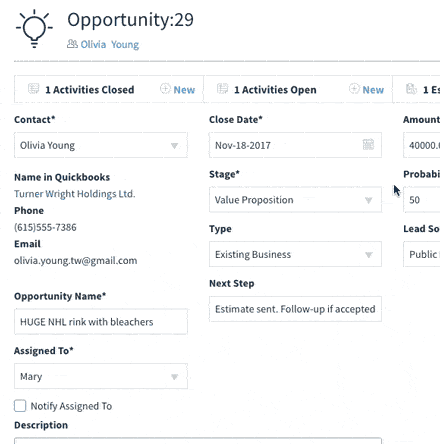
2. Stay focused on the most promising sales opportunities
There are only so many hours in a day, so you need to use them wisely.
However, this doesn’t mean spending an equal amount of time on each opportunity.
To effectively manage how to identify sales opportunities, use the data you’ve gathered to identify your most promising opportunities and prioritize those. These are often the deals:
- That produce the highest revenue.
- That are closest to closing.
- With the most engaged decision-makers.
Or, all of the above!
Regardless, the key to success is to have a process for recognizing which opportunities need special attention.
To better understand how to identify sales opportunities, each opportunity stage in Method CRM has an assigned probability percentage. Multiplying this percentage by the value of the opportunity gives you the amount of potential revenue in your pipeline.
For example, if you have a $1000 opportunity at the “Negotiating/Review” stage (90% probability; $900 in the pipeline) and a $1000 opportunity at the “Prospecting” stage (10% probability; $100 in the pipeline), it’s clear which one you should focus on.
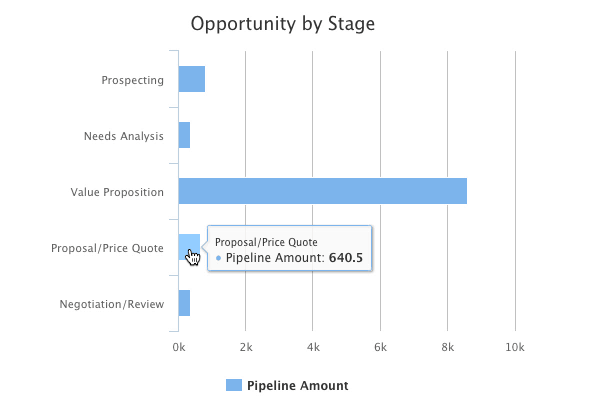
3. Stay in touch with your prospects
The odds of a web lead entering the sales process are 21 times greater if the company contacts the lead within five minutes, compared to responding after 30 minutes.
The same principle applies to existing sales opportunities in your pipeline. If you wait too long to follow up with your prospects, they may turn elsewhere.
So, you need to ensure that you answer questions promptly and that your sales team schedules appointments in a timely manner.
At every stage of the sales process, each opportunity should have a clear next step or follow-up activity. This may be an email, phone call, or something more industry-specific like a pitch presentation or product demo.
Logging these sales activities in your CRM helps to keep your team in the loop so you’re not accidentally contacting the same lead repeatedly.
Luckily, Method CRM makes it easy for you to see which users have upcoming and overdue activities. Plus, you can also filter your list of opportunities to view those with no scheduled follow-ups as shown below.
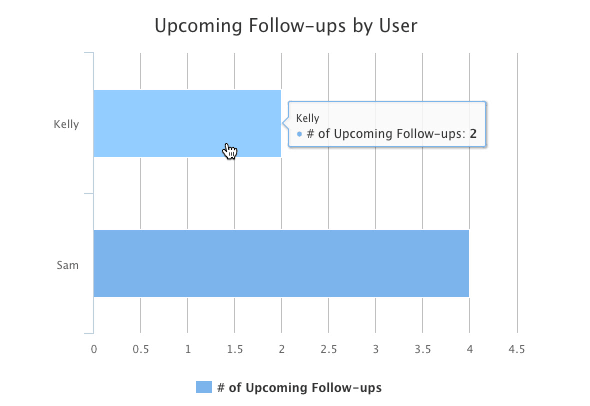
4. Keep your estimates organized
Nothing spoils an opportunity faster than promising to send your customer an estimate and failing to do so.
Whether you were waiting on someone else, didn’t have the necessary info, or were reluctant to clutter up QuickBooks, it doesn’t look good when you can’t deliver early in the sales process. This is a key indicator that you need a clearer opportunity management process.
Using a CRM that integrates with QuickBooks solves these problems by making it easy to send as many estimates as you need. Not only can you create estimates using QuickBooks items (without needing direct access), but these estimates live only in Method CRM so they don’t clutter your QuickBooks account.
Better yet, once you close a deal, you can instantly convert the final estimate to an invoice. This means that your opportunity stays in Method while your invoice automatically syncs to your QuickBooks account.
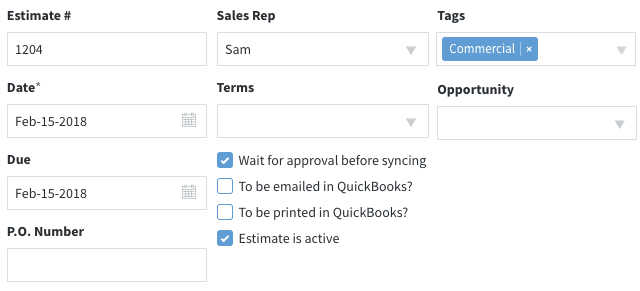
5. Evaluate your opportunity management process
To win more deals and increase sales, it’s critical to review your process outlining how to identify sales opportunities and customer demand. This survey should occur at regular intervals so you can track your progress over time and find areas for improvement.
The more insight you can gain into your sales process, the better equipped you’ll be to optimize it. Thankfully, Method CRM displays several key metrics that make it easier to learn how to identify sales opportunities. These include:
- The ratio of won to lost opportunities.
- The average deal size per sales rep.
- The amount of revenue per opportunity source.
You can also dive deeper into your CRM data to look at other valuable metrics, like the:
- Number of follow-ups per opportunity.
- Length of your sales cycle.
- Satisfaction of your leads with your sales approach.
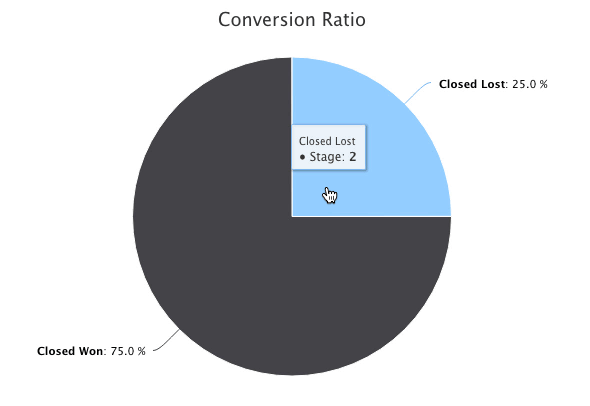
What’s next: What to do with leads and opportunities after you close a deal
Congrats! You now know how to identify sales opportunities and have turned your lead into a customer. But, your work is not yet over. Your focus should now be on your customer retention rate.
To keep your customers returning to your business, you must continue to nurture them to ensure that they continue to buy your products and services. Offering a special second-purchase discount or repeat customer perks are two easy ways to make sure you secure future sales opportunities from your existing customer base.
How to organize sales leads?
Successful companies use CRM software to segment leads based on various criteria like:
- Industry.
- Location in the world.
- Interest level.
Because these factors are centralized in the software, you can quickly access information and resources to tailor your sales strategy.
With CRM software, you filter each customer by how he or she:
- Is qualified based on potential revenue.
- Is segmented by customer demographics.
- Is reinforced by positive customer responses.
CRM software also:
- Simplifies the process for your sales team.
- Improves sales team collaboration.
- Lets you identify sales training and continuous learning opportunities.
What is opportunity management in sales?
In sales, opportunity management is the act of organizing deals currently in your sales pipeline.
Knowing how to identify sales opportunities helps you achieve your sales goals by prioritizing deals that are likely to succeed and strengthening your team’s sales approach.
Do you understand how to identify sales opportunities? Here are five signs that you need a designated system:
- You find it hard to determine which opportunities should be prioritized.
- You can’t measure the value of your sales opportunities.
- You don’t know the win/loss ratio of your opportunities.
- Your sales pipeline is slow and you see large gaps of time between customer touchpoints.
- You’re confused about what to do next when pursuing opportunities.
A proper opportunity management system helps you understand your prospects and potential customers. In turn, you can set priorities based on which ones are more likely to strike a deal with you.
Once you have an opportunity management system in place, you should follow these best practices:
- Research and find out the key details of every lead that enters your sales funnel.
- Break down your opportunities and prioritize the most promising ones.
- Automate busy work like sending a follow-up message and scheduling sales calls and meetings.
- Respond quickly to leads to show that you’re committed to delivering solutions.
- Ensure your sales team is on the same page with sales presentations.
What are sales opportunities?
Sales opportunities are prospects who are likely to become paying customers. They typically come from leads who see that your product or service can solve a pain point they have.
Opportunities start as leads. Leads are people who have shown interest in your product or service through one or more channels, such as downloading your promotional materials or receiving a sales call.
However, leads aren’t qualified yet, meaning they may not actually fit your buyer persona or have the budget to make a purchase.
It’s the responsibility of a salesperson to see whether a lead can feasibly buy and implement your product. If this prospect agrees to consider buying your product or service, it’s only then that they become sales opportunities.
To know how to identify sales opportunities in a lead or prospect, you need to identify these characteristics:
- Pain point: People buy a product to solve a problem, so you need to spot the prospect’s pain points. Sometimes these pain points aren’t immediately apparent, so you may need to dig deeper to find a pain point that your product can address.
- Interest in solving the issue: It isn’t enough to define the customer’s pain point. You also need to know if they want to solve this problem. If they’ve lived with that pain point for years, then there may be little interest in fixing it.
- Product fit: If the prospect is interested in solving the problem, then you need to look at your product and see if it fits their business profile. If it doesn’t, scan for another product to sell.
What is opportunity management in a CRM system?
In a CRM system, opportunity management is the process of tracking all potential sales opportunities to convert them into revenue. A CRM system lets you:
- Monitor and review your sales pipeline process.
- Prioritize your efforts on opportunities that are more likely to convert.
- Automate administrative tasks like email follow-ups and meeting schedules.
- Generate reports on sales pipeline performance.
- Find each opportunity that is uncovered through competitive research.
- Integrate and sync your tools with other platforms and processes.
Recap: Why you need a CRM for your opportunity management
Effective opportunity management takes time and effort, but the payoff is well worth it. If your business is struggling with how to identify sales opportunities in or outside of QuickBooks, it may be time to take a new course of action.
A CRM simplifies your opportunity management and gives you instant insights into your potential customers. For example, Method CRM helps you find how to identify sales opportunities effectively by:
- Tracking every interaction in the journey from lead to customer.
- Offering reporting that is recognized through market analysis.
- Providing you with a 360-degree view of every contact.
- Giving you an at-a-glance understanding of your sales pipeline and opportunities.
With Method CRM, it’s easy for you to take a data-driven approach when it comes to understanding how to identify sales opportunities.
Frequently asked questions (FAQs)
What sources can you use to identify new sales opportunities?
You can discover new sales opportunities from sources like:
- Customer feedback.
- Research on what each customer wants.
- Social media platforms.
- Industry networking events.
- CRM software with report generation features.
How do you attract sales?
Attracting sales involves a combination of:
- Targeted marketing.
- Nurturing customer relationships.
- Offering competitive pricing.
- Providing excellent customer service.
Observe how each customer is understood by analyzing customer pain points. Demand for your product or service is determined by gaps in the market, so look for any opportunity that emerges from customer feedback.
Our research indicates that a lead who is validated through customer testimonials is more likely to end up as a qualified opportunity. This means providing a place for customers to leave a review will more likely result in a new customer that is discovered through customer surveys.
How do you manage sales opportunities?
Managing sales opportunities involves tracking and analyzing each opportunity, often with the help of an integrated CRM platform. Prioritize opportunities using information that is targeted by understanding customer needs.
By developing a personalized approach for each opportunity and maintaining regular communication, your lead generation results will improve.
Ready to streamline your opportunity management? Start your free trial of Method CRM today!





